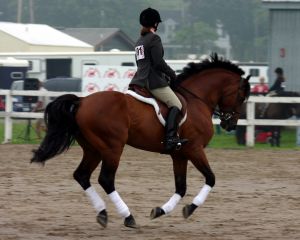 When you are learning how to canter on a horse, there are many problems that the movement of cantering can cause. These tips will minimise those problems so you can enjoy cantering a horse.
When you are learning how to canter on a horse, there are many problems that the movement of cantering can cause. These tips will minimise those problems so you can enjoy cantering a horse.
How To Canter
Cantering a horse is much the same as sitting trot, the seat (pelvis, thighs and hip joints) will be required to follow the canter movement. The seat should flow and remain in contact with the saddle forming a series of arcs (which may form an outline simular to that of the lower side of an egg which is laid on its side).
It can be described that there are 3 sensations to be felt at canter:
- First, a lowering or sinking of the seat. This coincides with the first hind-leg in the canter sequence coming down to touch the ground.
- Then, sliding or floating forward in the saddle. The upper body remains upright and tall. This corresponds with the horse shifting weight forward onto the next legs in the canter sequence.
- Finally a slight and gentle rise upward without the seat separating from the saddle. The sensations then start over again. This feeling comes from the moment of suspension in the canter from when the horse has pushed off the ground with the final leg in the sequence and prepares to start it over again.
At no point in the canter should the riders seat come away from the saddle This is the main fault in the canter that the rider is almost rising as in the trot but is rather thrown upwards out of the saddle then falls back into the saddle which potentially can cause the horse and rider some discomfort.
Lunging Exercises when Cantering
It is helpful if you can be lunged on a suitable horse with a good, regular, slow canter. A fast canter will make it more difficult to find you seat (we will look at positions for faster paces in future workbooks). Some causes of being up, out of the saddle are leaning or bringing the shoulders forward, gripping with the knee or thigh, uneven weight in the saddle, stiff pelvis or hips and the rider trying to sit still.
Once you are more experienced in riding a cantering horse, a good way to strengthen your seat, balance and position is to be lunged on a quiet horse (by an experienced person) riding without stirrups and reins.
Following the Movement of the Canter
Ideally when you are first learning how to canter a horse, you can be lunged. If you can be lunged so that you don’t have to worry about directing your horse, a useful technique for getting your seat into the saddle is to hold the front of the saddle with your inside hand and the back of the saddle with your outside hand. That means that if you a being lunged to the left your left hand will hold the front and your right hand the back. This technique will enable you to pull yourself into the saddle and help to put your body into the correct position for the direction you are travelling while you are following the movement of the canter.
Bumping on the Horses Back in the Canter
Another common problem is riders can follow the movement of the canter without bumping on the horses’ back but their seat is still such that daylight can be seen between them and the saddle. This is usually because the rider’s shoulders move forward and back with the canter rather than the hips and seat. Often times these riders just need to bring the shoulders further back to get their seat into the saddle and then allow the hips to move forward and back and the seat to slide in the saddle.
Losing Stirrups While Cantering
Another problem is the loss of stirrups while cantering. This is commonly caused by the rider gripping with the leg in an upwards motion which brings the weight out of the stirrup. Sometimes the toes of the rider also point out to the sides. A dilemma associated with this is the bottom half of the rider’s leg from the knee down appears to swivel forward and back with each canter stride. To rectify these problems the rider needs to allow the leg to stretch down with each canter stride and ensure the leg and knee are not gripping to the horse. It can be useful to check the length of the stirrups too. Stirrups which are too long will be difficult to keep and too short can cause the toe to swivel.
Rein Contact for the Canter
If the rein contact is too strong the horse may find your aids conflicting in that your legs and seat are saying ‘go’ but your hands are saying ‘whoa’. The opposite to this is that if the forward driving aids are too strong and rein contact too little you wont have much control when the horse picks up canter.
Horse Cantering Too Fast
Circling is a good way of progressively slowing a horse down into a slower pace. Circle sizes can be made smaller and smaller until the horse slows to the speed you want. This exercise can also help improve rough and difficult transitions to trot and slowing the trot down after canter. This is because the smaller circles can help encourage the horse to use their hind legs more to carry themselves from canter to trot which helps to develop smooth transitions. It is important to remember that when you ride the circles that they be consistent in size and shape and that they are ridden gradually from a larger to smaller circle. Sharp turns or spinning a horse onto a small circle can lead to injury and lameness.
Should you be having difficulty maintaining balance from canter to trot as for the upwards transition you can hold onto the saddle with one hand whilst using the other to guide the horse. Remember to sit deeply into the saddle with your shoulders back. Dropping the shoulders forward or rising out of the saddle in anticipation of trot makes your position vulnerable should the horse trip, stumble or shy.
Remember that when you are learning how to canter on a horse, that the cantering movement causes problems that are different to walk and trot. The tips for cantering on a horse above should minimise those problems so you can enjoy your ride!

